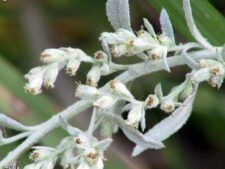
This aromatic, native perennial grows 1-4 feet tall, often occurring in loosely grouped colonies (C). Stem and leaves, especially the underside, are covered with dense, fuzzy hairs giving them a white to grayish-green cast. The unstalked, narrowly elliptical, alternate leaves are 1-4 inches long and are often lobed below as in the young, emerging plant shown in image (D). Inconspicuous, greenish-white tubular flower heads 1/8th inch in diameter occur in elongate, narrow clusters along the upper main stem and its branches. Each flower head contains several yellowish disk florets (B).
Found in drier, upland prairie sites. It is common in some, not all, of the prairies at Neale Woods. White Sage was uncommon at Fontenelle Forest in a Floodplain Prairie restoration near the blind prior to the flooding of 2011. It has not been seen since that time.
Flowering occurs in August and September.
Culinary sage is Salvia officinalis, an unrelated member of the Mint family (Lamiaceae). Native Americans used white sage for a variety of medicinal and ceremonial purposes. Pawnees bound a number of the tops together to form a broom used to sweep the lodge floors. Others burned the plant using the smoke to drive away mosquitoes.
Other common names include Louisiana Sage, Cudweed, Mugwort, Prairie Sage and Wormwood.
The content of NatureSearch is provided by dedicated volunteer Naturalists of Fontenelle Forest who strive to provide the most accurate information available. Contributors of the images retain their copyrights. The point of contact for this page is: Neal Ratzlaff.

 Identification
Identification

